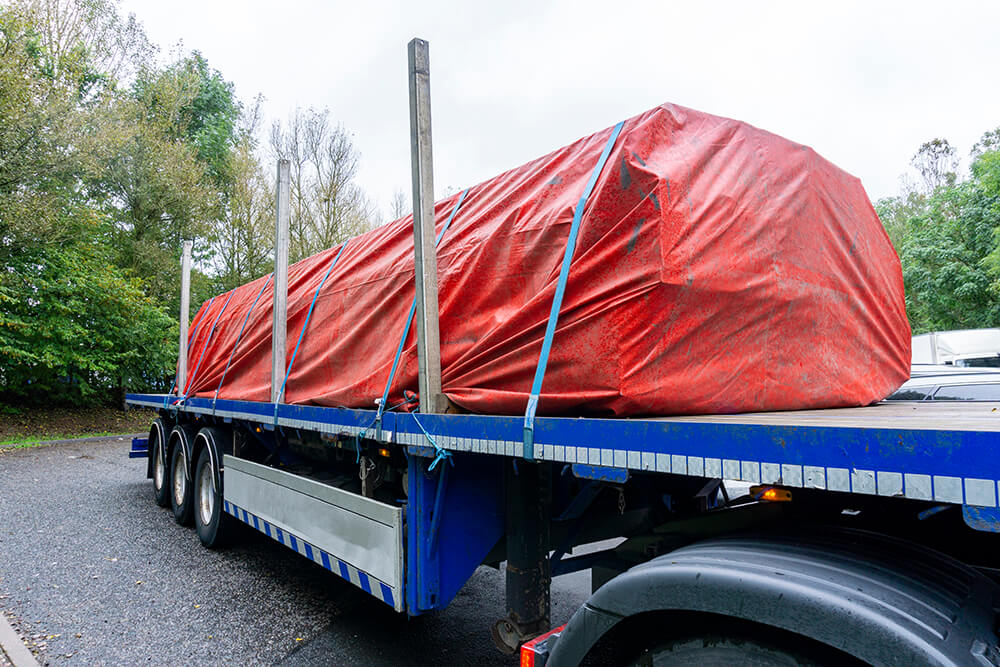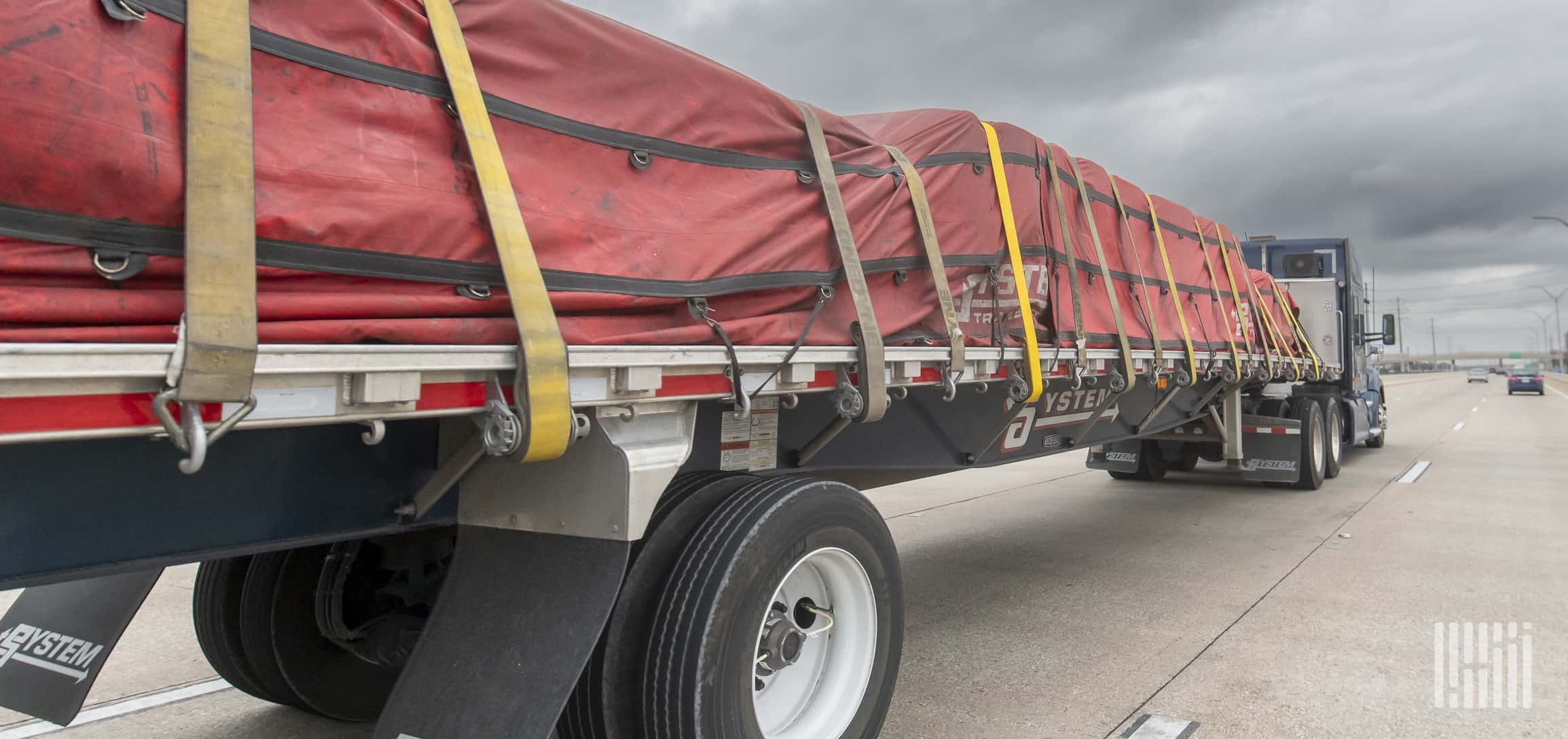
To tarp a flatbed load, start by securing the corners and edges with bungee cords, then use a heavy-duty tarp to cover the entire load, and finally secure the tarp with additional straps if necessary. Tarping a flatbed load is an essential part of transporting goods safely and efficiently.
Whether you’re hauling lumber, equipment, machinery, or any other cargo, properly securing and covering it with a tarp is crucial to protect it from the elements and ensure it reaches its destination in good condition. In this guide, we will walk you through the step-by-step process of tarping a flatbed load, providing you with valuable tips and techniques to make the task easier and more effective.
By following these instructions, you can ensure that your cargo stays protected and secure during transit, minimizing the risk of damage and maximizing your delivery success.

Credit: highwaydriverleasing.com
Navigate As You Want: [show]
Choosing The Right Tarp
When tarping a flatbed load, choosing the right tarp is essential. The material of the tarp determines its durability and suitability for different types of loads. Polyethylene tarps are popular for their lightweight and water-resistant properties, making them ideal for protecting loads against moisture. Vinyl tarps, on the other hand, are heavy-duty and offer excellent tear resistance and UV protection.
The size of the tarp should be considered to ensure proper coverage of the load. It is recommended to choose a tarp that is slightly larger than the load dimensions to allow for secure fastening. Additionally, tarps with reinforced edges and grommets provide better strength and stability during transportation.
Some features to consider when selecting a tarp include the presence of D-rings or hooks for secure tie-down, UV resistance to prevent sun damage, and the ability to resist mold and mildew. It is crucial to make an informed decision based on the load requirements and the environmental conditions it will be exposed to. By selecting the right tarp, flatbed loads can be effectively protected during transportation.
Preparing The Flatbed
Before tarping a flatbed load, it’s crucial that the flatbed is clean and clear of any debris or obstacles. This will ensure a smooth and secure tarping process. Additionally, it’s important to inspect the flatbed to make sure it’s free from any potential hazards that could damage the load or the tarp. Once the area is clean and clear, the load can be securely fastened to the flatbed using appropriate tie-down methods, such as straps or chains.
Securing The Tarp
To secure a flatbed load, center the tarp over the items and then pull the edges tightly. Use bungee cords or straps to keep the tarp in place and prevent it from shifting during transit.

Credit: www.myteeproducts.com
Ensuring Proper Coverage
Ensuring proper coverage when tarping a flatbed load is crucial to protect the cargo from external factors such as weather conditions and debris. Checking for gaps is the first step in this process, as even small openings can expose the load to potential damage. Inspect the edges of the tarp and make sure it is tightly fastened using bungee cords or straps to secure loose areas. Pay attention to the corners and seams, where gaps are more likely to occur. Additionally, consider using corner protectors and edge protectors for added security. Maintaining a tight and secure tarp is essential for the safe transportation of the load, preventing shifting during transit. Properly covering the flatbed load with a secure tarp ensures that the cargo arrives at its destination intact and undamaged.
Final Inspections
To ensure a flatbed load is securely tarped, conducting final inspections is crucial. The first step is checking for secure fastenings, examining each tie-down, ratchet, and bungee cord to confirm they are tightly secured and in good condition. A quick tug can help identify any loose or damaged fastenings that need immediate attention.
Next, it’s important to verify the integrity of the tarp itself. Inspect the tarp for any tears, holes, or weak spots that could compromise its ability to protect the load. Address any issues found, either by repairing the tarp or replacing it if necessary.
Remember, an improperly secured or damaged tarp can lead to accidents and lost cargo. By performing thorough final inspections, you can ensure the load is properly tarped and ready for transport.

Credit: ratings.freightwaves.com
Frequently Asked Questions For How To Tarp A Flatbed Load
How Do You Tarp A Flatbed Load?
To tarp a flatbed load, start by selecting the appropriate size and type of tarp. Next, secure the corners of the tarp to the load using bungee cords or straps. Then, evenly distribute the tarp over the load, making sure it is tightly secured.
Finally, double-check for any loose areas and make necessary adjustments.
What Are The Benefits Of Tarping A Flatbed Load?
Tarping a flatbed load offers several benefits. Firstly, it protects the cargo from external elements such as rain, debris, and UV rays. Secondly, it prevents potential damage during transportation, ensuring the load arrives in good condition. Additionally, tarping complies with legal regulations, avoiding fines and penalties.
Lastly, it demonstrates professionalism and care for the client’s goods.
What Are The Different Types Of Flatbed Tarps?
There are various types of flatbed tarps available. Common options include lumber tarps, steel tarps, coil tarps, machinery tarps, and smoke tarps. Each type is designed to cater to specific cargo requirements, offering features such as waterproofing, UV resistance, and durability.
How Long Does It Take To Tarp A Flatbed Load?
The time to tarp a flatbed load varies depending on several factors, such as the size and shape of the load, experience level, and weather conditions. It can take anywhere from 10 to 30 minutes on average, but more complex loads may require additional time for proper tarping.
Conclusion
Properly tarping a flatbed load is crucial for ensuring the safety and security of the cargo. By following the step-by-step guide outlined in this blog post, you can effectively protect your load from the elements and prevent any potential damage or accidents.
Remember to choose the right tarp material, secure it tightly using bungee cords or ratchet straps, and regularly inspect the tarp for any signs of wear and tear. By implementing these tips, you can confidently transport your flatbed load with peace of mind.


